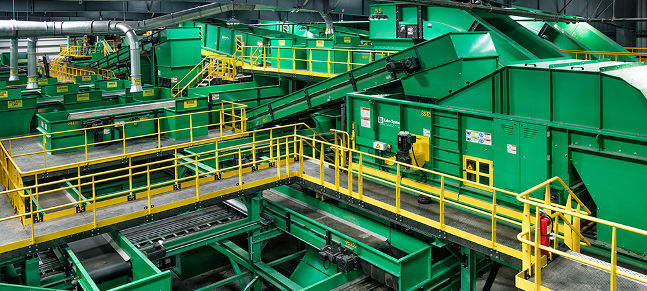Overview of the Market
The recycling equipment market is a critical component of the global waste management ecosystem, enabling the transformation of discarded materials into valuable resources. This sector includes machinery for sorting, shredding, baling, washing, and processing various waste streams, supporting industries ranging from municipal services to manufacturing.
According to industry analysis, the global recycling equipment market was valued at USD 31.3 billion in 2024. It is expected to grow to USD 32.3 billion by 2025 and reach USD 42.8 billion by 2030, achieving a compound annual growth rate (CAGR) of 5.6% during the 2025–2030 forecast period. This expansion reflects increasing regulatory pressure, rising waste volumes, and growing industrial demand for recycled inputs.
The market’s evolution is driven by the need to address environmental concerns while meeting economic objectives. As waste generation accelerates globally, investments in advanced recycling technologies have become essential for compliance, efficiency, and sustainability.
Key Market Drivers
Stringent Environmental Regulations
Governments worldwide are implementing stricter waste management and recycling mandates. Policies aimed at reducing landfill use and promoting material recovery are compelling industries to adopt advanced equipment. These regulations create a direct demand for technologies that ensure high recovery rates and compliance with recycling targets.
Rapid Urbanization and Waste Growth
The United Nations Environment Programme (UNEP) estimates that global municipal solid waste will increase from 2.3 billion tonnes in 2023 to 3.8 billion tonnes by 2050. Without effective recycling systems, the economic cost of unmanaged waste could exceed USD 640.3 billion annually by mid-century. Recycling equipment is essential to process this growing volume and prevent environmental overload.
Demand for Recycled Materials
Industries such as automotive, packaging, electronics, and construction are under pressure to incorporate recycled content. This shift requires high-purity inputs, which in turn depend on sophisticated sorting and processing equipment. The circular economy model—where materials are reused indefinitely—relies heavily on reliable recycling infrastructure.
Market Restraints
High Capital and Operational Costs
Advanced recycling systems require significant upfront investment. For small and medium enterprises (SMEs), especially in developing regions, these costs can be prohibitive. Maintenance, energy consumption, and skilled labor further increase the financial burden, limiting adoption among smaller operators.
Operational Challenges
Variability in waste composition poses technical difficulties. Mixed or contaminated waste streams reduce equipment efficiency and output quality. In regions with inconsistent waste collection systems, achieving optimal performance remains a persistent challenge.
Growth Opportunities
Technological Advancements
The integration of artificial intelligence (AI), automation, and sensor-based systems is transforming recycling operations. Optical sorters, robotic arms, and AI-driven quality control improve accuracy, speed, and material recovery rates. According to the International Energy Agency (IEA) Bioenergy report (2024), advanced sorting technologies significantly enhance recycling efficiency.
Emerging solutions such as laser delamination, cryogenic processing, and ultrasonic separation are expanding capabilities in complex material streams like e-waste and composites. These innovations support higher-value recycling and align with zero-waste goals.
Policy Support and Infrastructure Investment
Extended Producer Responsibility (EPR) frameworks, circular economy initiatives, and government funding are creating favorable conditions for market growth. Investments in material recovery facilities (MRFs), composting plants, and specialized recycling hubs are driving equipment demand.
Market Segmentation
By Equipment Type
- Sorting & Separation: Optical sorters, magnetic separators, eddy current separators, air classifiers, sensor-based systems
- Shredding & Size Reduction: Single/dual/quad-shaft shredders, granulators, hammer mills, crushers
- Baling & Densification: Vertical/horizontal balers, briquetting machines
- Conveying & Feeding: Belt, chain, and pneumatic conveyors
- Washing & Drying: Friction washers, float/sink tanks, dewatering systems
- Extrusion & Pelletizing: Single/twin-screw extruders, strand pelletizers
- Specialized Systems: E-waste dismantlers, battery recycling units, robotic sorting cells
By Material Type
- Plastics, metals (ferrous/non-ferrous), paper/cardboard, glass, rubber, e-waste, C&D waste, organics, textiles, batteries, composites
By End User
- Municipalities, waste management firms, construction recyclers, automotive dismantlers, electronics processors, packaging reclaimers, paper mills, bioenergy plants
By Region
- North America: U.S., Canada, Mexico
- Europe: U.K., Germany, France, Italy, Spain, Nordic countries, Russia
- Asia-Pacific: China, Japan, India, South Korea, Australia, Indonesia, Thailand
- Rest of World: Latin America, Middle East, Africa
Asia-Pacific is the fastest-growing region due to rapid urbanization and industrial expansion, while Europe leads in regulatory-driven innovation.
Competitive Landscape
Leading companies include:
- TOMRA Systems ASA
- Vecoplan AG
- SSI Shredding Systems
- UNTHA shredding technology
- Eldan Recycling A/S
- Metso, ANDRITZ
- BHS-Sonthofen GmbH
- HAMMEL Recyclingtechnik GmbH
- Pellenc ST, CP Manufacturing, Inc.
These firms focus on R&D, automation, and energy efficiency. Recent strategic moves include product launches, facility expansions, and acquisitions to strengthen market position.
Recent Developments
- May 2025: TOMRA launched the X-TRACT wood recycling unit for higher material purity.
- 2024: Vecoplan invested €13 million in German headquarters and introduced the VIZ 1300 shredder.
- 2025: ANDRITZ acquired ATN Engineering for refrigerant recycling technology.
- June 2024: Veolia deployed AI robotic arm with Recycleye in London, achieving 35–50 picks/minute.
- April 2025: U.S. EPA released EPR Framework for Batteries, increasing demand for specialized equipment.
- 2024–2025: India strengthened EPR norms for plastics, tires, e-waste; Delhi and Mumbai launched large-scale e-waste parks.
- March 2024: Thailand established SEZ in Chachoengsao for EV battery recycling.
Conclusion
The recycling equipment market is on a steady growth path, projected to reach USD 42.8 billion by 2030. Supported by regulatory enforcement, technological innovation, and rising material demand, the sector plays a pivotal role in global sustainability efforts.
While high costs and operational complexities remain challenges, advancements in AI, automation, and policy frameworks are creating new opportunities. As industries and governments align on circular economy principles, recycling equipment will continue to evolve as an indispensable tool for waste reduction, resource conservation, and environmental protection.





Comments